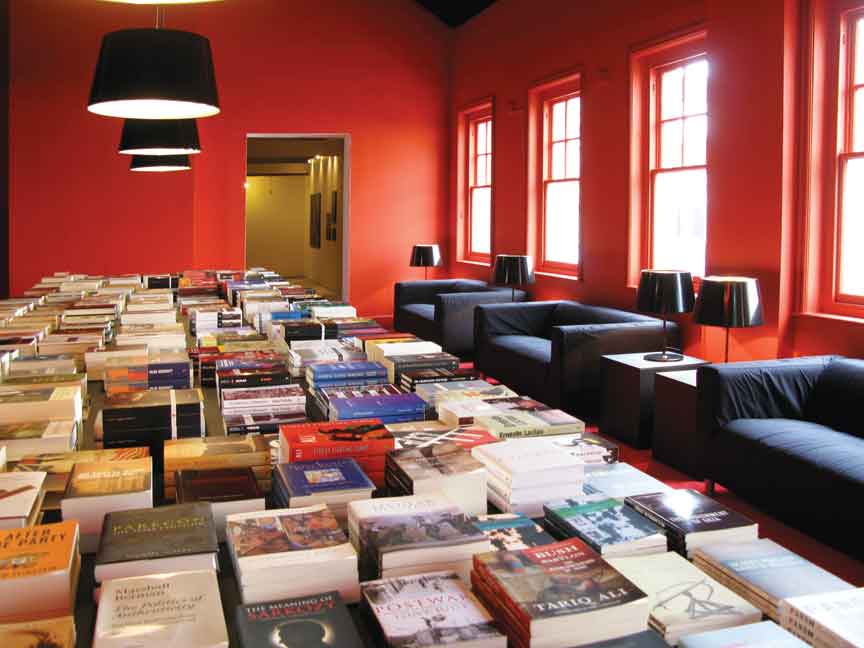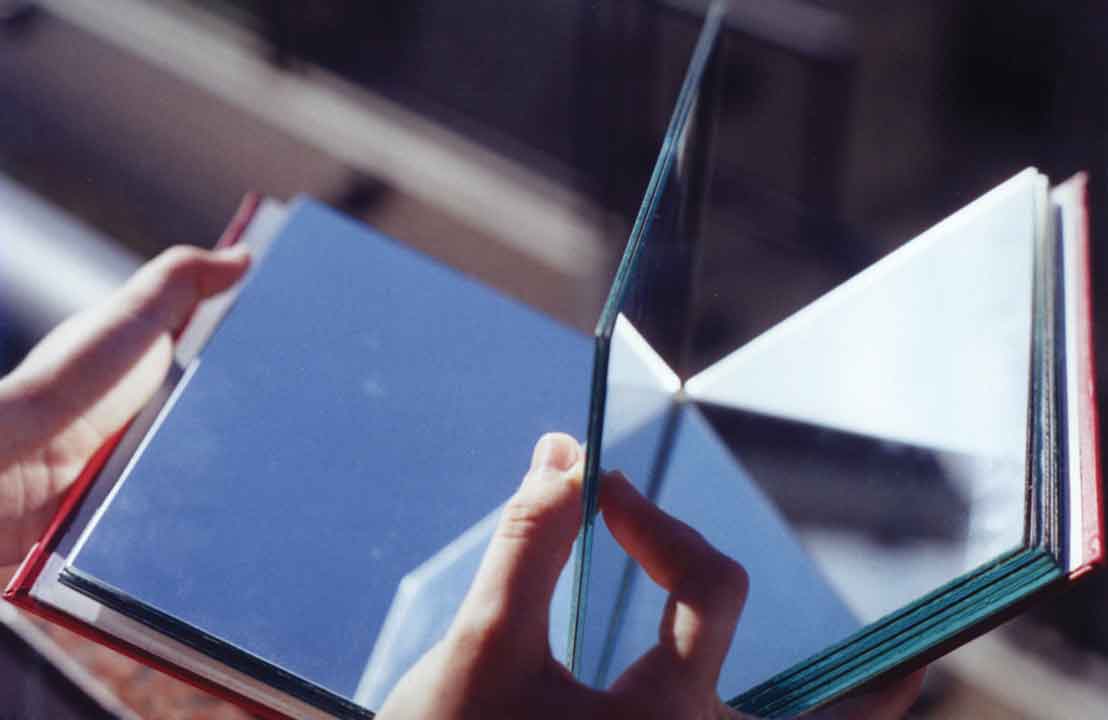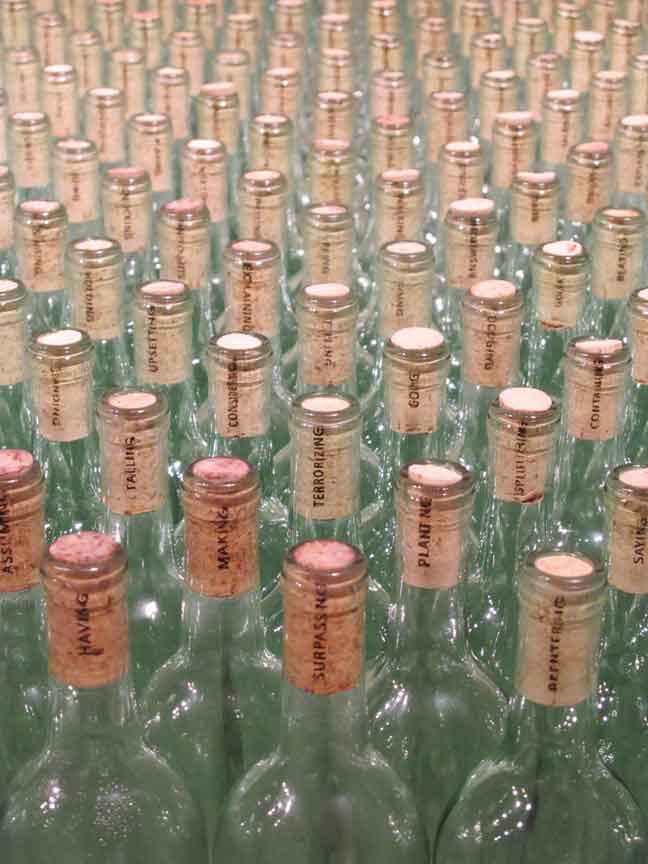« Features
The Art of Storytelling

Alfredo Jaar, Marx Lounge, 2010, site-specific installation with 1500 books all related to Marxist theory. Courtesy of the artist.
By Selene Wendt
Storytelling and narration have played a significant role in contemporary art for quite some time, materializing as a trend that has developed alongside the increasing popularity of documentary practices in art. Storytelling seems to be capturing everyone’s attention as an ever-increasing number of exhibitions feature strongly narrative work. Whether historically, politically or personally based, narrative tendencies in contemporary art range from highly straightforward and factual to magical and fairytale-like. There is no shortage of contemporary art that conveys narratives relating to topics of sexuality and race, identity issues, philosophy, politics, and life in general. At a time when storytelling in art is so firmly established, there are also many artists whose work is directly inspired not only by narrative strategies, but also by literature in particular.
“The Storytellers: Narratives in International Contemporary Art” features work by contemporary artists from around the world whose creations are directly inspired by literature1. The exhibition was initially inspired by a personal interest in Latin American literature and its distinct tradition of storytelling. Authors such as Jorge Luis Borges, Pablo Neruda, Mario Vargas Llosa, Gabriel García Márquez, Octavio Paz and Reinaldo Arenas have all had a tremendous influence on the development of literature and poetry, both in their own countries and internationally. Neruda’s poems, Borges’ labyrinths and García Márquez’s magical realism have provided a valuable source of inspiration not only for readers and other authors, but also for artists. While the inspirational seed for this exhibition was planted in Latin America, it has grown and blossomed far beyond its roots, reaching across geographical, linguistic and creative borders. The result is a large-scale exhibition that features contemporary artists from all over the world whose work is also inspired by authors such as James Joyce, William Blake, Karl Marx, Virginia Woolf, Italo Calvino and Arthur Rimbaud.
The exhibition title is directly inspired by Vargas Llosa’s book The Storyteller, a captivating story with an intricate narrative that juxtaposes the voice of the narrator with chapters relating to Peruvian Indian mythology. The Storyteller contains all the elements of a classic award-winning novel: an underlying personal struggle and a search for meaning and truth found along the path of a life-changing journey of discovery. Vargas Llosa’s award-winning story hints at many of the underlying themes in the exhibition and captures the unique and powerful storytelling qualities of many of the artists featured in “The Storytellers.” Just as Vargas Llosa guides us into a mythic and magical world with his poetic tale of a storyteller, these artists are visual storytellers who capture our imagination with their interpretations of some of the greatest stories ever written.

Mónica Bengoa, Einige Beobachtungen über Wildblumen: Bienen-Ragwurz (Ophrys apifera) und Schachblume (Fritillaria meleagris) or Some considerations on wild flowers: Bee Orchid (Ophrys apifera) and Chess Flower (Fritillaria meleagris), 2011, wall-mounted mural made from hand-cut felt. Courtesy of the artist
“The Storyteller” is also the title of a celebrated essay by Walter Benjamin, written specifically about the work of Nikolai Leskov. Benjamin’s reflections on the qualities and power of true storytellers are highly relevant within the general context of literary theory, and also within the specific context of this exhibition. Although Benjamin feared the end of the art of traditional storytelling, his words are nonetheless insightful. He writes, “Counsel woven into the fabric of real life is wisdom. The art of storytelling is reaching its end because the epic side of truth, wisdom, is dying out” (86). Benjamin had a very valid point in terms of oral storytelling, but clearly the art of storytelling in the written form will never die out, and visual storytelling is blossoming like never before. Benjamin describes the inherent qualities of storytelling, placing emphasis on the roles of both the storyteller and the listener. Within the context of this particular exhibition, the parallel is easily extended to the roles of artist and viewer.

Ernesto Neto, Circleprototemple, 2010, installation, Plywood, polyaminde foam, cotton coruroy, elastic cord, samba drum, drumstick. Courtesy of Galeria Fortes Vilaça, Sao Paulo
“Storytelling is always the art of repeating stories, and this art is lost when the stories are no longer retained. It is lost when there is no more weaving and spinning to go on while they are being listened to. The more self-forgetful the listener is, the more deeply is what he listens to impressed upon his memory. When the rhythm of work has seized him, he listens to the tales in such a way that the gift of retelling them comes to him all by itself. This, then, is the nature of the web in which the gift of storytelling is cradled. This is how today it is becoming unravelled at all its ends after being woven thousands of years ago in the ambience of the oldest forms of craftsmanship” (Benjamin 90-91).
The installations, sculptures, photographs, films, paintings and drawings featured in “The Storytellers” are not literal interpretations, nor are they illustrative, but they are all deeply inspired in some way by literature and/or poetry. As with any story, the narratives are intricate and intertwined, sometimes overlapping, move in and out of time and place, are rich with metaphor and symbolism, and are conveyed with unequivocal power and conviction. Some of the narratives evolve from personal journeys while others are more analytical or theoretical in approach, but all the works tell stories that are as personal as they are universal. The golden thread that ties these works together is typically spun from pre-existing literary narratives, found in timeless, epic stories that are uniquely transformed into new stories in their own right. The cross between text and image, poetry and poetic subject matter brings all the work together into a large-scale exhibition that can be read and enjoyed on a variety of different levels. Reading between the lines of these works, we are invited to discover what shapes this exhibition into visual storytelling at its best.
The artists featured in this exhibition are storytellers in their own right, with a unique ability to convey narratives through visual art that is paradoxically as indebted to words, text and language as it is detached from the words, text and language that inspired them in the first place. While the play between text and image is certainly nothing new, these works reveal a very specific and unique link to literature. The essence of the exhibition lies in the references to specific literary narratives as well as the individual narratives that are also inspired by literature and books. Real books, imaginary books, replicas of books, book collections, pages from books, passages from books, pictures of books, installations of books and sculptures carved from books might all seem part of an imaginary Borgesian universe. As featured within “The Storytellers,” these books are visual translations that tell or retell captivating stories that ultimately trace a path from Borges to Joyce, Brazil to Norway, the 19th century to the 21st century and back again, all expressed in art that speaks even louder than words.

Marilá Dardot, The Book of Sand, 1999, bound book with pages of mirrors. Courtesy of Galeria Vermelho, Sao Paulo.
During the curatorial process a clear division between various strategies gradually emerged, both formally and conceptually speaking. Three different approaches stood out in particular: works that include actual books; works that are based on interpretations of specific books or stories; and narrative works that are more loosely inspired by literature and storytelling. With so much interesting contemporary art inspired by literature readily available, I was interested in featuring major works such as Alfredo Jaar’s The Marx Lounge, Ernesto Neto’s Circleprototemple and Elida Tessler’s Dubling along with new works created specifically for the exhibition. Had it not been for the logistical challenge of transporting thousands of books across the Atlantic and having to build a life-size pier for Cildo Meireles’ Surge of the Sea or the astronomical cost and complexity of rebuilding a house for Marilá Dardot and Fabio Morais’ Far Away, Right Here, these works could very well have been included in the first version of the exhibition presented at the Stenersen Museum in Oslo. As the exhibition travels to Latin America, the possibility of including alternate works, and even additional artists, is possible, with the aim of letting new stories and narratives unfold.
Georges Adéagbo, Ryan Brown, Milena Bonilla, Eloisa Cartonera, Alfredo Jaar, Fabio Morais and Valeska Soares are among the artists whose work includes actual books, or at least what appear to be books. Equally powerful are the works based on interpretations of specific books or stories, as seen in those by Liliana Angulo, Mónica Bengoa, Monika Bravo, María Magdalena Campos-Pons, William Córdova, Marilá Dardot, Cristina Lucas, Ernesto Neto, Ulf Nilsen, Rosana Ricalde, Eder Santos, Tracey Snelling, Elida Tessler, Sergio Vega and Nina Yuen. This includes three different interpretations of Italo Calvino’s Invisible Cities, a large-scale felt mural inspired by an encyclopedia, an interactive installation inspired by Borges’ The Circular Ruins, a massive installation that includes 4,311 wine bottles, relating to the same number of verbs found in James Joyce’s Ulysses, and a truly Borgesian book of mirrors, among many other fascinating works. Finally, Lobato & Guimarães, William Kentridge, and Young-Hae Chang Heavy Industries provide an interesting contrast to other works in the exhibition, with their strongly narrative videos that are inspired more loosely by literature and storytelling.

Elida Tessler, Dubling, 2010, mixed-media installation consisting of 4311 wine bottles with corks, and a special table that contains 4311 postcards. Courtesy of the artist and CIFO, Cisneros Fontanals Art Foundation, Miami, FL.
The stories that unfold in “The Storytellers” range from short to long, and are quite possibly already familiar to the viewer. Interestingly, the narratives are typically more important than actual words or texts. These artists tell a wide variety of stories through visual means that extend far beyond written language. Ultimately, their works transcend the borders of geography, language and discipline and collectively convey universal stories of life.
Jacques Rancière speaks quite convincingly about the role of the artist as storyteller, describing an emancipated community as one made up of storytellers and translators.
“Artists, just as researchers, build the stage where the manifestation and the effect of their competences become dubious as they frame the story of a new adventure in a new idiom. The effect of the idiom cannot be anticipated. It calls for spectators who are active as interpreters, who try to invent their own translation in order to appropriate the story for themselves and make their own story out of it. An emancipated community is in fact a community of storytellers and translators. I am aware that all this may sound as: words, mere words. But I would not hear this as an insult.”2
Each of the artists featured in “The Storytellers” build a stage where they not only frame the story of a new adventure in a new idiom, they reframe, restage and re-create stories that have already been told. As viewers, we take on the role of spectator and are inspired to play an active role as interpreters. There is no escaping the immediacy of these works, and the more time we take to read between the lines, embracing our roles as interpreters, the richer the stories become.
WORKS CITED
- Walter Benjamin, “The Storyteller.” Illuminations. London: Pimlico, 1999. Essay originally published in 1936, first translated into English in 1968.
NOTES
1. “The Storytellers” is curated by Selene Wendt, in collaboration with Gerardo Mosquera. Participating artists include: Georges Adéagbo, Liliana Angulo, Mónica Bengoa, Milena Bonilla, Monika Bravo, Ryan Brown, María Magdalena Campos-Pons, Eloisa Cartonera, William Córdova, Marilá Dardot, Alfredo Jaar, William Kentridge, Lobato & Guimarães, Cristina Lucas, Fabio Morais, Ernesto Neto, Ulf Nilsen, Rosana Ricalde, Eder Santos, Tracey Snelling, Valeska Soares, Elida Tessler, Sergio Vega, Young-Hae Chang Heavy Industries, and Nina Yuen. This essay is adapted from Selene Wendt’s essay included in the book published by Skira in conjunction with the exhibition. The book also features texts by Mario Vargas Llosa, Gerardo Mosquera and Paco Barragán, as well as an interview between Marilà Dardot and Cao Guimarães.
2. Excerpt from a lecture by Jacques Rancière that was originally presented at the opening of the 5th international summer academy in Frankfurt on August 20, 2004. In a revised form it is published in Artforum, XLVI, No. 7 (March 2007).
Selene Wendt is an art historian and curator who works as the director of the Stenersen Museum, in Oslo, Norway. She has curated numerous international exhibitions, most notably “The Storytellers: Narratives in International Contemporary Art.” In addition, she is editor of Crispin Gurholt Live Photo Volume II and Marianne Heske: A Doll’s House, both published by Skira, and co-editor with Paco Barragán of When a Painting Moves… Something Must be Rotten!, published by Charta in 2011.



































Leave a Reply
You must be logged in to post a comment.